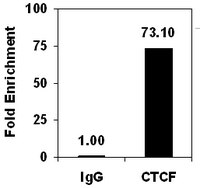17-10044 Sigma-AldrichChIPAb+ CTCF - ChIP Validated Antibody and Primer Set
The ChIPAb+ CTCF set includes the CTCF antibody, a negative control antibody (normal mouse IgG) & qPCR primers which amplify a 165 bp region of human H19 internal control region.
More>> The ChIPAb+ CTCF set includes the CTCF antibody, a negative control antibody (normal mouse IgG) & qPCR primers which amplify a 165 bp region of human H19 internal control region. Less<<Recommended Products
Overview
| Replacement Information |
|---|
Key Specifications Table
| Species Reactivity | Key Applications |
|---|---|
| H | WB, DB, IHC, IP, ELISA, Mplex, ChIP |
| References |
|---|
| Product Information | |
|---|---|
| Format | Purified |
| Control |
|
| Presentation | Anti-CTCF, (mouse monoclonal IgG1κ. One vial containing 50 μg of protein G purified mouse monoclonal IgG1κ in buffer containing 0.1 M Tris-Glycine (pH 7.4, 150 mM NaCl) with 0.05% sodium azide, before the addition of glycerol to 30%. Store at -20°C. Normal Mouse IgG. Two vials containing 25 µg purified IgG in 25 µL storage buffer containing 0.1% sodium azide. Store at -20°C. ChIP Primers, Human H19 ICR. One vial containing 75 μL of 5 μM of each primer specific for human H19 internal control region. Store at -20°C. FOR: CCC ATC TTG CT GACC TCAC REV: AGA CCT GGG ACG TTT CTG TG |
| Quality Level | MQ100 |
| Physicochemical Information |
|---|
| Dimensions |
|---|
| Materials Information |
|---|
| Toxicological Information |
|---|
| Safety Information according to GHS |
|---|
| Safety Information |
|---|
| Packaging Information | |
|---|---|
| Material Size | 25 assays |
| Material Package | 25 assays per set. Recommended use: ~2 μg of antibody per chromatin immunoprecipitation (dependent upon biological context). |
| Transport Information |
|---|
| Supplemental Information |
|---|
| Specifications |
|---|
| Global Trade Item Number | |
|---|---|
| Catalog Number | GTIN |
| 17-10044 | 04053252679230 |
Documentation
ChIPAb+ CTCF - ChIP Validated Antibody and Primer Set SDS
| Title |
|---|
ChIPAb+ CTCF - ChIP Validated Antibody and Primer Set Certificates of Analysis
| Title | Lot Number |
|---|---|
| ChIPAb+ CTCF - 2108581 | 2108581 |
| ChIPAb+ CTCF - 2377389 | 2377389 |
| ChIPAb+ CTCF - 2433563 | 2433563 |
| ChIPAb+ CTCF - 2006937 | 2006937 |
| ChIPAb+ CTCF - 2246838 | 2246838 |
| ChIPAb+ CTCF - 3150649 | 3150649 |
| ChIPAb+ CTCF - 3380454 | 3380454 |
| ChIPAb+ CTCF - 3529581 | 3529581 |
| ChIPAb+ CTCF - 3562370 | 3562370 |
| ChIPAb+ CTCF - 3698765 | 3698765 |









